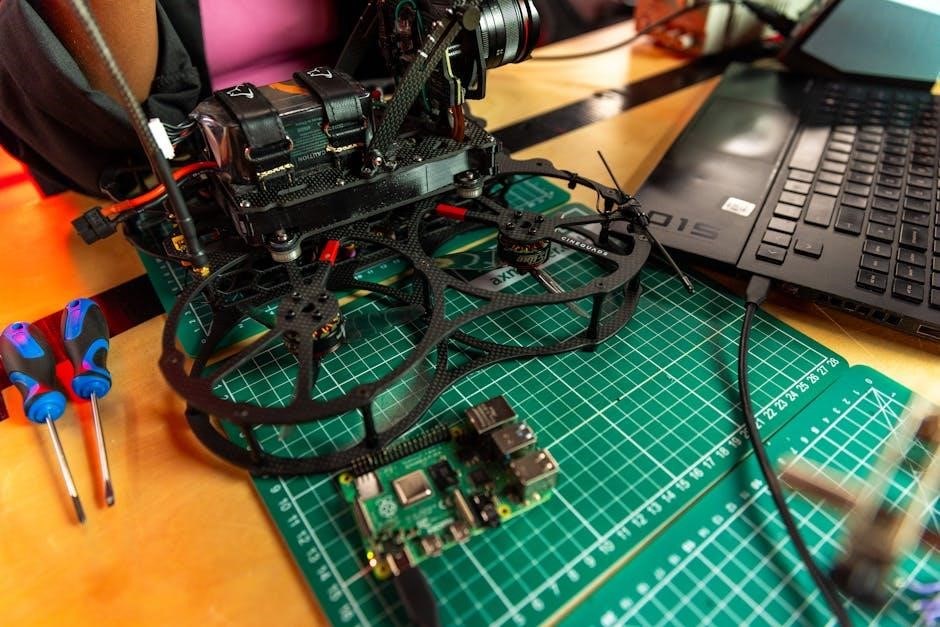EverStart Battery Charger Manual Overview
EverStart battery chargers provide a crucial function for vehicle owners by ensuring reliable battery maintenance. The owner’s manual serves as a guide‚ containing essential information for safe and effective operation. It outlines features‚ functions‚ safety precautions‚ and troubleshooting steps.
Understanding EverStart Battery Chargers
EverStart battery chargers are designed to efficiently charge and maintain various types of 12V batteries‚ including AGM‚ GEL‚ and WET. These chargers often feature multiple charging modes‚ such as automatic and manual‚ and some models include functionalities like engine start assistance and alternator check. They provide a convenient way to keep your vehicle’s battery in optimal condition‚ ensuring reliable starting power and extending battery life. Familiarizing yourself with the specific features and capabilities of your EverStart charger is crucial for safe and effective use‚ as detailed in the owner’s manual.
Importance of the Owner’s Manual
The owner’s manual is an indispensable resource for effectively utilizing your EverStart battery charger. It provides detailed instructions on proper operation‚ safety precautions‚ and troubleshooting common issues. Consulting the manual ensures that you understand the charger’s capabilities and limitations‚ preventing misuse or damage. It guides you through connecting the charger‚ selecting appropriate charging modes‚ and interpreting LCD display information. Furthermore‚ the manual outlines essential safety guidelines to minimize risks associated with battery charging‚ such as ensuring proper ventilation and correct clamp connections. By carefully following the owner’s manual‚ you can maximize the performance and lifespan of both your charger and battery.
Key Features and Functions (BC50BE as Example)
The EverStart BC50BE boasts versatile charging modes‚ including automatic and manual options. It also offers an engine start function‚ an alternator check‚ and a battery reconditioning cycle. These features enhance its utility and user convenience.
Battery Charging Modes (Automatic‚ Manual)
EverStart battery chargers offer both automatic and manual charging modes for optimal battery care. The automatic mode intelligently adjusts the charging process based on the battery’s condition‚ ensuring efficient and safe charging. In contrast‚ the manual mode allows users to set the charging parameters themselves‚ offering more control. Selecting the appropriate mode depends on the user’s experience and the specific requirements of the battery. The automatic mode is ideal for beginners‚ while the manual mode caters to experienced users who prefer precise control over the charging process.
Engine Start Functionality
EverStart battery chargers with engine start functionality provide a convenient solution for jump-starting vehicles with weak or dead batteries. This feature delivers a high current boost to crank the engine‚ allowing users to quickly start their vehicle without needing another car or jump-start cables. The engine start function is designed for emergency situations and should be used cautiously‚ following all safety instructions. It’s crucial to refer to the owner’s manual for specific guidance on using the engine start function and to avoid potential damage to the vehicle’s electrical system.
Alternator Check Function
The alternator check function on EverStart battery chargers offers users a valuable diagnostic tool to assess their vehicle’s charging system. This feature helps determine if the alternator is properly charging the battery while the engine is running. By following the instructions in the owner’s manual‚ users can connect the charger to the battery and initiate the alternator check. The charger will then analyze the alternator’s output and provide an indication of its performance. This feature assists in identifying potential alternator issues before they lead to battery drain or vehicle breakdowns.
Battery Reconditioning
The battery reconditioning feature available on some EverStart battery chargers is designed to rejuvenate and extend the life of lead-acid batteries. This function uses a specialized charging cycle to help break down sulfate crystals that accumulate on the battery plates over time. Sulfation reduces the battery’s ability to hold a charge‚ leading to diminished performance. The reconditioning process involves applying a controlled series of pulses to dissolve the sulfate buildup‚ restoring the battery’s capacity. It is important to consult the owner’s manual for specific instructions and precautions before using the battery reconditioning function.

Safety Precautions
Safety precautions are paramount when operating any battery charger. The EverStart owner’s manual details essential safety guidelines. These guidelines reduce the risk of electrical shock‚ fire‚ or battery explosion‚ ensuring user safety during operation.
General Safety Instructions
General safety instructions are critically emphasized within the EverStart battery charger owner’s manual. Always wear eye protection when working with batteries‚ and ensure the area is well-ventilated. Never smoke or allow open flames nearby during the charging process‚ as batteries produce explosive gases. Disconnect the charger from the power source before disconnecting the clamps.
Keep the charger away from water and moisture to prevent electrical hazards. Regularly inspect the charger’s cords and clamps for damage‚ replacing them if necessary. Do not operate the charger if it has been dropped or damaged. Children should never operate the charger.
Proper Ventilation and Charger Placement
Proper ventilation and charger placement are essential for safe operation‚ as outlined in the EverStart battery charger manual. Always operate the charger in a well-ventilated area to prevent the buildup of explosive gases produced during battery charging. Position the charger as far away from the battery as the cables permit to minimize the risk of sparks igniting the gases.
Avoid placing the charger on flammable surfaces or near combustible materials. Ensure the charger is placed on a stable‚ level surface to prevent it from tipping over. Never cover the charger during operation‚ as this can lead to overheating.
Correct Clamp Connections (Polarity)
Correct clamp connections (polarity) are crucial for safe and effective battery charging using an EverStart charger. The owner’s manual emphasizes the importance of connecting the red (positive) clamp to the positive terminal of the battery and the black (negative) clamp to the negative terminal. Reversing the polarity can damage the battery‚ charger‚ and vehicle electrical system.
For negative-grounded vehicles‚ connect the positive clamp to the ungrounded positive post of the battery. Always double-check the polarity before plugging the charger into a power source. Incorrect connections can result in sparks or damage to the equipment.
Operating Instructions
Operating the EverStart battery charger involves several key steps. These steps include determining the battery voltage‚ correctly connecting the charger to the battery‚ selecting the appropriate charging mode‚ and carefully monitoring the charging progress using the LCD display.
Determining Battery Voltage
Before initiating the charging process with your EverStart battery charger‚ accurately determining the battery voltage is essential for optimal performance and safety; Consult your vehicle’s manual to identify the correct voltage specification for your battery‚ typically 12 volts for most automotive applications. Using the charger on a battery with a different voltage than what it is designed for can cause damage to the battery‚ charger‚ or even create a safety hazard. This ensures compatibility and prevents potential damage or safety risks during the charging procedure.
Connecting the Charger to the Battery
Properly connecting the EverStart charger to the battery is crucial for safe and effective charging. Begin by ensuring both the charger and vehicle are powered off. Identify the positive (+) and negative (-) terminals on the battery. Attach the red clamp from the charger to the positive terminal and the black clamp to the negative terminal‚ ensuring a secure connection. Double-check the polarity to prevent reverse connections‚ which can damage the charger and battery. Once connected‚ ensure the charger is placed on a flat‚ stable surface‚ away from any flammable materials‚ before proceeding.
Selecting the Appropriate Charging Mode
Choosing the correct charging mode on your EverStart battery charger is essential for optimal battery care. Consult your vehicle’s manual to determine the battery voltage‚ typically 12V. The EverStart Maxx chargers often feature automatic modes that adjust charging based on battery condition. For manual selection‚ choose the appropriate voltage and amperage setting. Using an incorrect mode can lead to overcharging or undercharging‚ potentially shortening the battery’s lifespan. Refer to the owner’s manual for specific recommendations on selecting the best charging mode for your battery type and condition to ensure safe and efficient charging.
Monitoring Charging Progress (LCD Display Details)
The LCD display on EverStart battery chargers provides crucial real-time feedback on the charging process. The display typically shows the battery’s voltage‚ charging current (amps)‚ and the charging mode selected. A blinking green light indicates charging in progress‚ while a solid green light signifies a full charge. Some models display error codes‚ which are essential for troubleshooting. The LCD helps monitor the charging progress‚ ensuring that the battery is charging correctly. By understanding the information displayed‚ you can prevent overcharging and ensure the battery reaches its optimal charge level efficiently‚ extending its overall lifespan.

Troubleshooting
The troubleshooting section addresses common issues encountered while using the EverStart battery charger. It offers solutions for error codes‚ connection problems‚ and charging failures. Consulting this section helps resolve issues‚ ensuring proper charger operation and battery maintenance.
Common Issues and Solutions
The EverStart battery charger may encounter several common issues that users should be aware of. One frequent problem is the charger failing to recognize a connected battery‚ often due to poor terminal connections or a deeply discharged battery. Ensuring proper clamp connections and attempting a manual charge mode can resolve this. Another issue is the charger displaying error codes; these are usually explained in the manual‚ offering specific solutions. Overheating can also occur‚ prompting the charger to shut down. Ensuring adequate ventilation and reducing the charging current can mitigate this problem.
Understanding Error Codes (if applicable)
EverStart battery chargers sometimes display error codes to indicate specific issues encountered during operation. These codes are essential for diagnosing problems and implementing the correct solutions. The owner’s manual provides a comprehensive list of error codes and their corresponding meanings. For instance‚ an error code might indicate reverse polarity‚ a faulty battery‚ or an internal charger malfunction. Always refer to the manual to accurately identify the error. Attempting to interpret error codes without consulting the manual can lead to incorrect troubleshooting steps. Understanding error codes is crucial for efficient maintenance and preventing potential damage;

Maintenance and Storage
Proper maintenance and storage of your EverStart battery charger ensures longevity and reliable performance. This section details how to clean the charger safely and outlines ideal storage conditions to prevent damage.
Cleaning the Charger
To ensure the safe and effective operation of your EverStart battery charger‚ regular cleaning is essential. Before cleaning‚ always disconnect the charger from the power source and the battery. Use a dry cloth to wipe down the charger’s housing‚ removing any dust or debris. Avoid using liquids‚ as they can cause electrical shock or damage the internal components. Inspect the clamps for corrosion and clean them with a wire brush if necessary. Ensure all connections are secure and free from dirt. Regular cleaning will prolong the charger’s lifespan and maintain its optimal charging performance.
Proper Storage Conditions
To maximize the lifespan and performance of your EverStart battery charger‚ proper storage is crucial. Before storing‚ ensure the charger is disconnected from both the power source and the battery. Clean the charger thoroughly‚ removing any dirt or debris. Store the charger in a cool‚ dry place‚ away from direct sunlight and extreme temperatures. Avoid storing the charger in areas with high humidity or exposure to corrosive substances. Neatly coil the cables to prevent damage and tangling. By following these storage guidelines‚ you can ensure your charger remains in optimal condition for future use‚ providing reliable performance when needed.

Warranty Information
The EverStart battery charger typically includes a warranty covering defects. Refer to the warranty documentation for specific coverage details‚ limitations‚ and the process for submitting a warranty claim. Keep your purchase receipt safely.
Warranty Coverage Details
The EverStart battery charger warranty typically covers defects in materials and workmanship under normal use. The duration of the warranty can vary‚ so it is important to consult the specific warranty documentation included with your charger or available on the retailer’s website. Coverage generally includes repair or replacement of the charger at the manufacturer’s discretion. Damages resulting from misuse‚ abuse‚ or unauthorized repairs are usually excluded. Some warranties may also require proof of purchase and adherence to the operating instructions outlined in the owner’s manual. Check the document for details.
How to Claim Warranty
To initiate a warranty claim for your EverStart battery charger‚ you will typically need to contact the retailer from which you purchased the charger or the manufacturer directly. Prepare to provide proof of purchase‚ such as a receipt or order confirmation. Describe the issue you are experiencing with the charger in detail‚ and have the model number and serial number readily available. Follow the instructions provided by the retailer or manufacturer‚ which may involve returning the charger for inspection. Ensure you package the charger securely to prevent damage during shipping.
